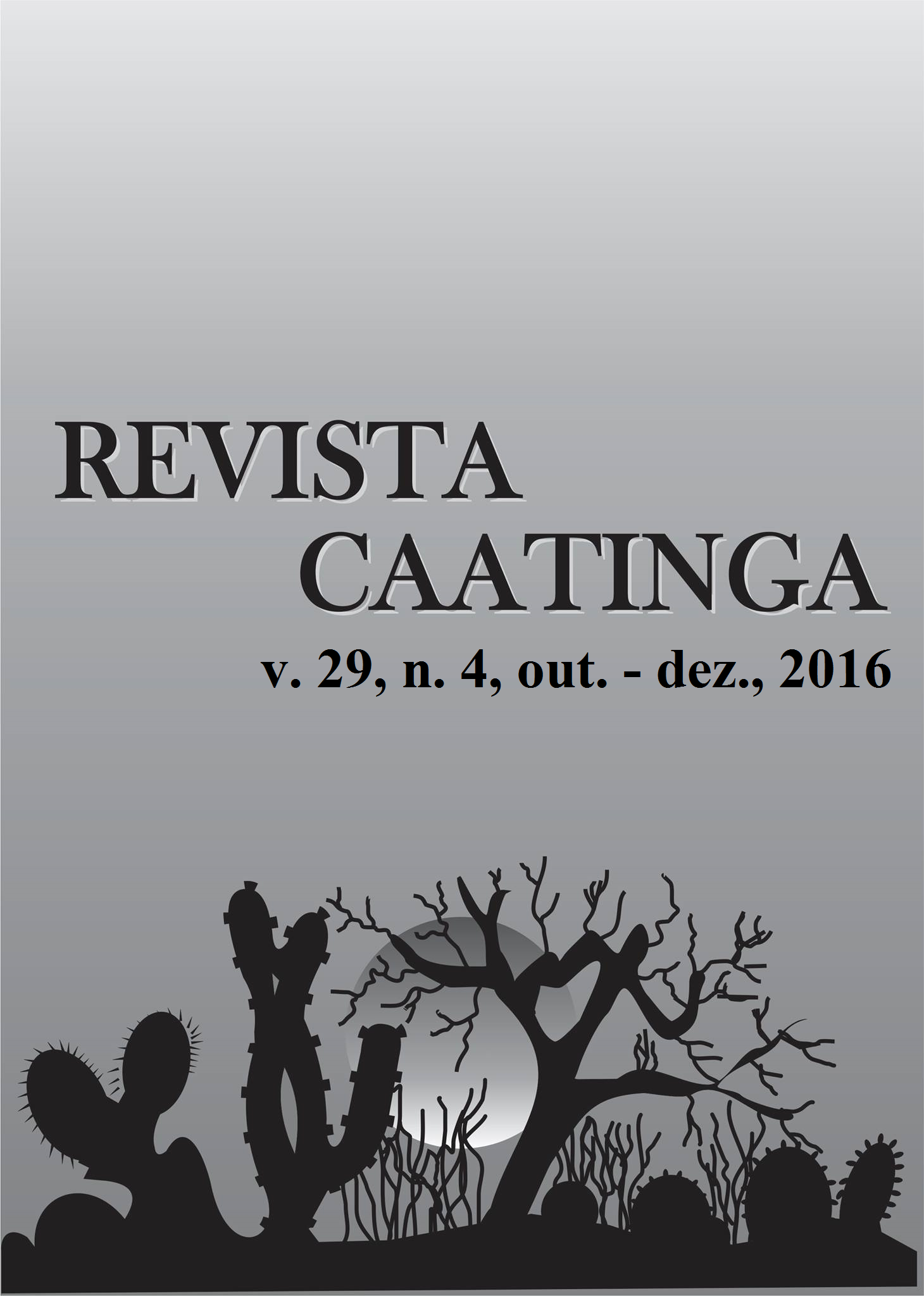EVALUATION OF CORN HYBRIDS UNDER CONTRASTING WATER AVAILABILITY CONDITIONS
DOI:
https://doi.org/10.1590/1983-21252016v29n418rcKeywords:
Adaptability. Stability. Drought.Abstract
The current study aimed to assess adaptability and stability of corn hybrids regarding grain yields when sown in three different seasons in the Brazilian cerrado. The research was carried out at the Experimental Farm of the IF Goiano, campus in Ceres - GO. Pre-sowing fertilization was made with 20 kg ha-1 of nitrogen, 150 kg ha-1 of phosphorus and 80 kg ha-1 of potassium (04-30-16 formulation). Data were analyzed in a random block experimental design. We assessed tem corn hybrids (Truck, Fórmula, P30F53, P3646H, P30F35H, AGN 30A77H, AGN 30A37H, AG 8088PRO, DKB 390 and DKB Bi9440) in three sowing seasons (Nov. 18, 2011; Jan. 31, 2012 and Feb. 20, 2012) with three replications. Harvests were held on Apr. 4, 2012; Jun. 10, 2012 and Jul. 1, 2012. Each hybrid were assessed on yielding; and a graphical analysis was made to contrast hybrids and sowing seasons regarding stability and adaptability. Results showed a significant effect of the interaction between hybrids and sowing times. Therefore, we may state that the best hybrid in an environment would not be necessarily good in another. Thereby, we can infer that drought and corn genetic variability have diverse behaviors in each season. Over the two-dimensional graphics generated by GGE Biplot method, we observed an increased adaptability of AGN 30A77H when sown on Nov. 18, 2011 and on Jan. 31, 2012, followed by Fórmula; however, for P30F35H, it was on Feb. 20, 2012.Downloads
References
BRASIL. Companhia Nacional de Abastecimento. Acompanhamento da safra brasileira de Grãos. Disponível em: <http://www.conab.gov.br/OlalaCMS/uploads/arquivos/15_09_11_10_42_03_boletim_graos_setembro_2015.pdf> . Acesso em: 24 mar. 2016.
CAMARGO-BUITRAGO, I. et al. Identificación de megaambientes para potenciar el uso de genótipos superiores de arroz en Panamá. Pesquisa Agropecuária Brasileira, Brasília, v. 46, n. 9, p. 1601-1069, 2011.
CARVALHO, H. W. L. et al. Adaptabilidade e estabilidade de híbridos de milho em diferentes condições ambientais do Nordeste Brasileiro. Revista Brasileira de Milho e Sorgo, Sete Lagoas, v. 1, n. 2, p. 75-82, 2002.
CRUZ, C. D.; REGAZZI, A. J.; CARNEIRO, P. C. S. Modelos biométricos aplicados ao melhoramento genético. 3. ed. Viçosa, MG: 2004. 480 p.
FORSTHOFER, E. L. et al. Desempenho agronômico e econômico do milho em diferentes níveis de manejo e épocas de semeadura. Pesquisa Agropecuária Brasileira, Brasília, v. 41, n. 3, p. 399-407, 2006.
FRUTOS, E.; GALINDO, M. P.; LEIVA, V. An interactive biplot implementation in R for modeling genotype-by-environment interaction. Stochastic Environmental Research and Risk Assessment, Berlin, v. 28, n. 7, p. 1629-1641, 2014.
LOPES, S. J. et al. Relações de causa e efeito em espigas de milho relacionadas aos tipos de híbridos. Ciência Rural, Santa Maria, v. 37, n. 6, p. 1536-1542, 2007.
OLIVEIRA, J. S. et al. Estratificação de ambientes, adaptabilidade e estabilidade de híbridos comerciais de milho para silagem no sul do Brasil. Ciência Rural, Santa Maria, v. 34, n. 4, p. 997-1003, 2004.
PAULA, T. O. M. et al. Pi statistics underlying the evaluation of stability, adaptability and relation between the genetic structure and homeostasis in popcorn. Acta Scientiarum: Agronomy, Maringá, v. 32, n. 2, p. 269-277, 2010.
R. Development core team: A language and environment for statistical computing. R Foundation for Statistical Computing, Vienna. Disponível em: <http://www.R-project.org/>. Acesso em: 03 mar. 2014.
SCAPIM, C. A.; CARVALHO, C. G. P.; CRUZ, C. D. Uma proposta de classificação dos coeficientes de variação para a cultura do milho. Pesquisa Agropecuária Brasileira, Brasília, v. 30, n. 5, p. 683-686, 1995.
SILVA, R. R.; BENIN, G. Análises biplot: conceitos, interpretações e aplicações. Ciência Rural, Santa Maria, v. 42, n. 8, p. 1404-1412, 2012
SOUZA, R. S. et al. Desempenho produtivo de genótipos de milho sob déficit hídrico. Revista Brasileira de Milho e Sorgo, Sete Lagoas, v. 14, n. 1, p. 49- 60, 2015.
TOLLENAAR, M.; LEE, E. A. Yield potential, yield stability and stress tolerance in maize. Field Crops Research, Amsterdan, v. 75, n. 2, p. 161-169, 2002.
UNITED STATES. United States Department of Agriculture. Data and Statistics: Foreign Agricultural Service. Available in: <http://www.usda.gov/wps/portal/usda/usdahome?navid=DATA_STATISTICS>. Access in: 10 mar. 2014.
YAN, W.; HOLLAND, J. B. A heritability-adjusted GGE biplot for test environment evaluation. Euphytica, Wageningen, v. 171, n. 3, p. 355- 369, 2010.
Downloads
Published
Issue
Section
License
Os Autores que publicam na Revista Caatinga concordam com os seguintes termos:
a) Os Autores mantêm os direitos autorais e concedem à revista o direito de primeira publicação, com o trabalho simultaneamente licenciado sob a Licença Creative Commons do tipo atribuição CC-BY, para todo o conteúdo do periódico, exceto onde estiver identificado, que permite o compartilhamento do trabalho com reconhecimento da autoria e publicação inicial nesta revista, sem fins comerciais.
b) Os Autores têm autorização para distribuição não-exclusiva da versão do trabalho publicada nesta revista (ex.: publicar em repositório institucional ou como capítulo de livro), com reconhecimento de autoria e publicação inicial nesta revista.
c) Os Autores têm permissão e são estimulados a publicar e distribuir seu trabalho online (ex.: em repositórios institucionais ou na sua página pessoal) a qualquer ponto antes ou durante o processo editorial, já que isso pode gerar alterações produtivas, bem como aumentar o impacto e a citação do trabalho publicado (Veja O Efeito do Acesso Livre).







